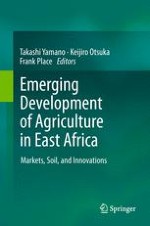2011 | OriginalPaper | Chapter
8. Optimal Fertilizer Use on Maize Production in East Africa
Authors : Tomoya Matsumoto, Takashi Yamano
Published in: Emerging Development of Agriculture in East Africa
Publisher: Springer Netherlands
Activate our intelligent search to find suitable subject content or patents.
Select sections of text to find matching patents with Artificial Intelligence. powered by
Select sections of text to find additional relevant content using AI-assisted search. powered by
